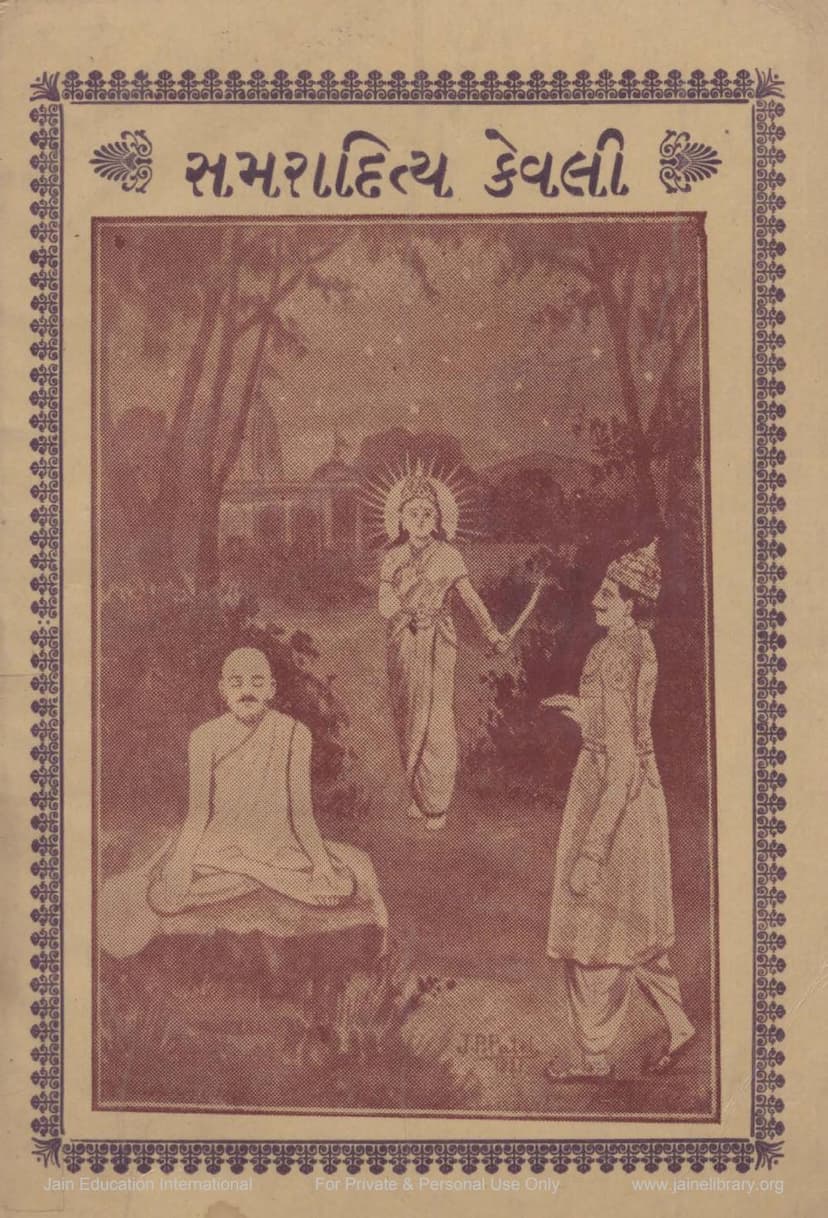Samaraditya Kevali
Added to library: September 2, 2025

Summary
This is a comprehensive summary of the Jain text "Samaraditya Kevali" by Chidanandsuri, based on the provided catalog link and the text itself.
Book Title: Samaraditya Kevali Author: Chidanandsuri Publisher: Jain S M Sangh Nandarbar Catalog Link: https://jainqq.org/explore/005171/1
Overall Summary:
"Samaraditya Kevali" is a Jain religious text that recounts the life story of Samaraditya and his previous births, illustrating core Jain principles through narrative. The book emphasizes the importance of Dharma (righteous conduct), vairagya (detachment from worldly affairs), karma, and the path to liberation (moksha). It highlights how actions in past lives influence present circumstances and the ultimate goal of attaining Kevali Gnan (omniscience) and liberation. The narrative follows Samaraditya through nine significant lifetimes, detailing his spiritual journey and the lessons learned from encounters with virtue and vice, adherence to Jain vows, and overcoming worldly attachments.
Key Themes and Content:
-
The Importance of Dharma Kathas: The editorial section (Page 5) stresses that among the four divisions of Jain literature (Dravyanuyog, Ganitanuyog, Karananuyog, and Kathanuyog), Kathanuyog is most effective in guiding individuals toward the path of Dharma. It distinguishes between harmful worldly stories and beneficial Dharma stories that cultivate virtues like humility, simplicity, non-attachment, penance, self-control, contentment, and celibacy.
-
The Life of Samaraditya Kevali: The book is a compilation of the nine previous lives of Samaraditya, who eventually achieved Keval Gnan. Each life serves as a moral lesson.
-
Nine Previous Lives: The index (Page 11) provides a detailed list of the nine lives described in the book, along with their central characters and notable events or parables:
- 1st Life: King Gunasean and Agni Sharma. Features the parable of the unmindful traveler.
- 2nd Life: Simhakumar and Anand (father-son). Includes parables of the clairvoyant monk and the drop of honey.
- 3rd Life: Shikikumar and Jalinī (son-mother). Discusses the difficulties of asceticism and answers to nihilists.
- 4th Life: Dhana and Dhanashri (husband-wife). Recounts the story of Yashodhara and the evils of meat-eating.
- 5th Life: Jay and Vijay (brothers). Features the life of Acharya Sankumar and two types of forests.
- 6th Life: Dharan and Lakshmi (husband-wife). Includes the autobiography of Ahindatta.
- 7th Life: Sen and Vishern (cousins). Details the past life of a female ascetic and the mother-son parable on harsh speech.
- 8th Life: Gunachandra and Vanmantar Vidhyadhar. Covers the life of Acharya Vijayadharma, the assembly of Tirthankar Dev, the life of Sugata Sadhvi, detachment upon seeing a river, and the suffering in the four realms.
- 9th Life: Samaraditya and Girina Chandal. Describes three types of delusion and seven parables.
-
Acharya Haribhadrasuri: The book acknowledges that the original "Samaraditya Katha" was composed by Acharya Haribhadrasuri, a prominent Jain scholar and disciple of Yakshini Mahattara. His conversion from a learned Brahmin to a Jain scholar is recounted, highlighting his intellectual prowess and humility.
-
The Editor and Publisher: The editor is identified as A. Shri Chidanandsuri, a disciple of Acharya Shri Nipunprabh Surishwarji Maharaj. The publisher is Shri Jain Shwetambar Murtipujak Sangh, Nandurbar.
-
Focus on Virtues and Detachment: The text consistently emphasizes the cultivation of virtues and the practice of detachment from worldly pleasures, possessions, and relationships as a means to spiritual progress and liberation. The parables often illustrate the temporary and ultimately painful nature of worldly pursuits.
-
Karma and Rebirth: The concept of karma is central, explaining how past actions determine present and future births and experiences. The narrative of Samaraditya's nine lives demonstrates the consequences of actions across multiple lifetimes.
-
The Teachings of Jainism: The book implicitly and explicitly conveys Jain teachings on non-violence (ahimsa), truthfulness (satya), non-stealing (asteya), celibacy (brahmacharya), non-possession (aparigraha), and the path to spiritual purity.
-
The Importance of Renunciation: Many of the lives depict the protagonists eventually renouncing worldly life to embrace asceticism and pursue spiritual liberation, highlighting the ultimate value of renunciation over worldly pleasures.
-
The Role of Gurus and Spiritual Guidance: The text shows the crucial role of enlightened gurus and spiritual guides in helping individuals understand the nature of reality, overcome ignorance, and follow the path of Dharma.
-
The Editor's Dedication: The editor, Chidanandsuri, expresses his intention to make this knowledge accessible to contemporary readers, especially the youth, in a simple and illustrated format. He seeks forgiveness for any inaccuracies.
Overall Message:
"Samaraditya Kevali" serves as a moral and spiritual guide, encouraging readers to reflect on the consequences of their actions, cultivate virtues, practice detachment, and strive for spiritual liberation by following the path of Dharma as exemplified by Samaraditya's lives. The book aims to inspire spiritual transformation and remind readers of the transient nature of worldly happiness and the eternal bliss of spiritual freedom.